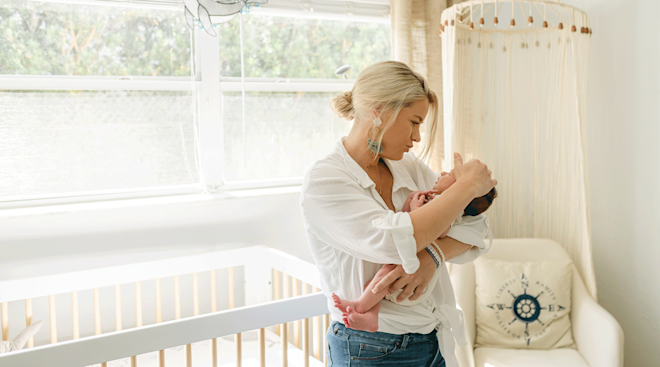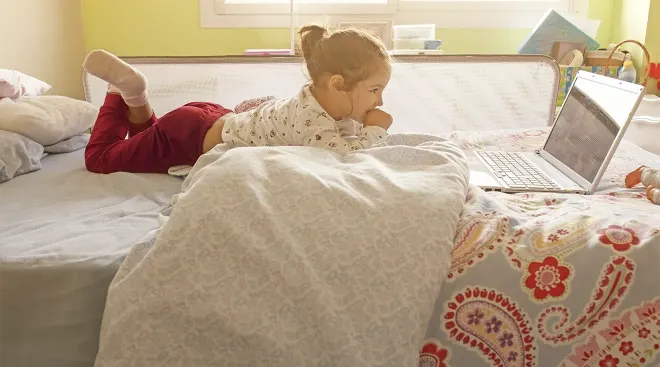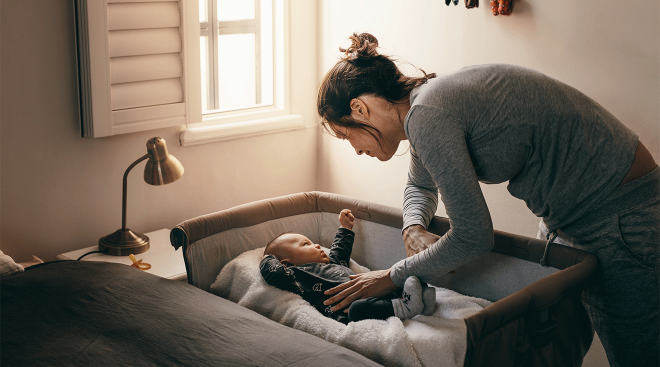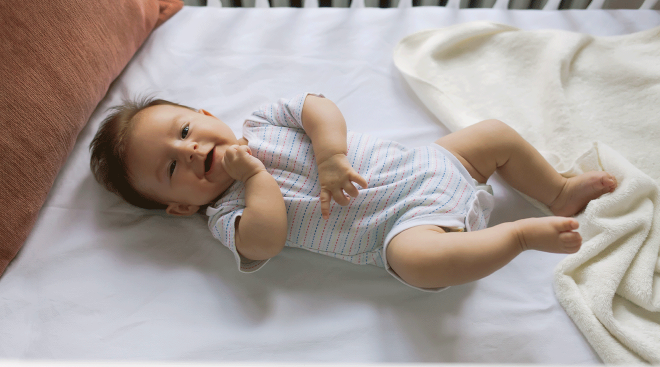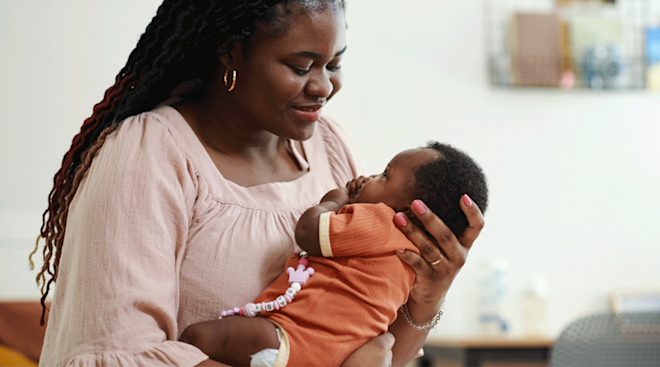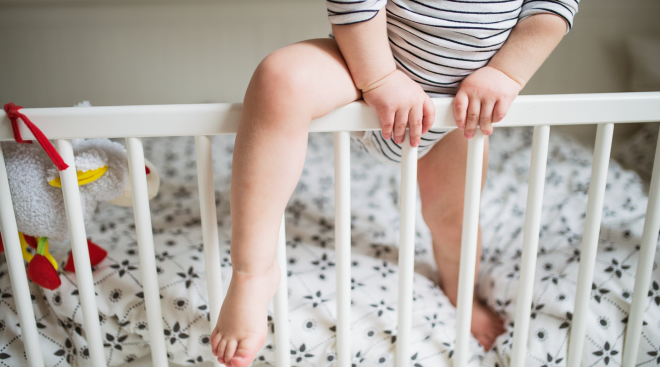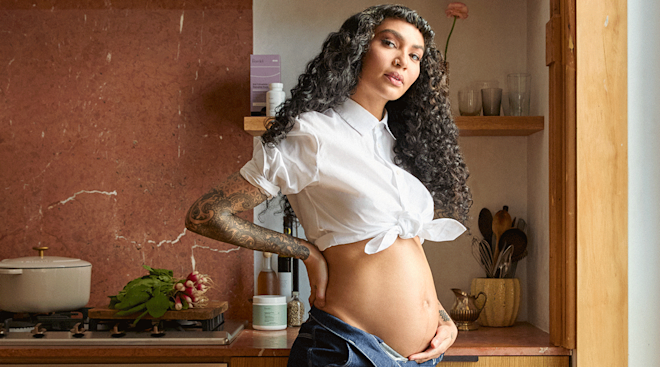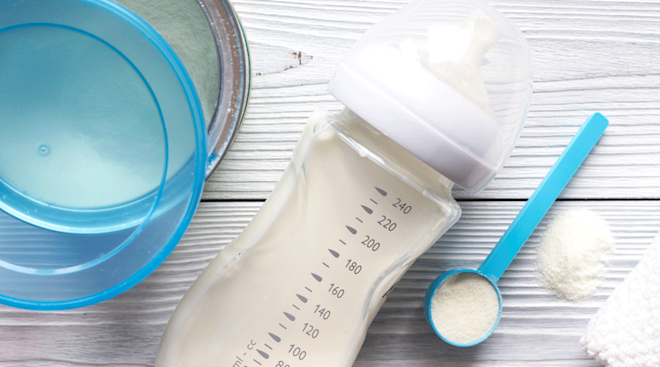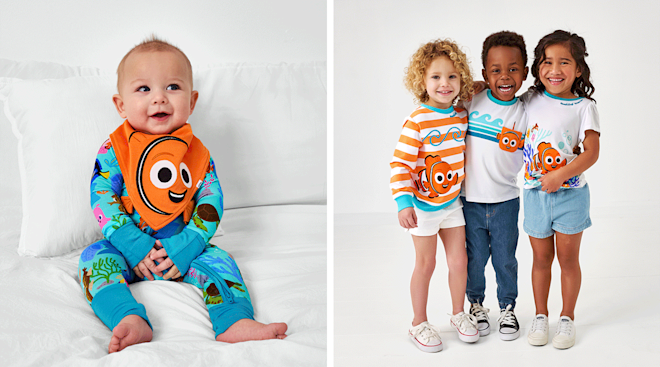How (and When) to Establish a Baby Bedtime Routine
It’s no secret that young children need a lot of sleep to support their development and growth. According to the American Academy of Pediatrics, getting enough sleep helps kids build a healthier immune system and improve their behavior, memory and mental health. One of the best things you can do to help baby get the shut-eye they need? Establish a baby bedtime routine early on.
There’s a reason experts recommend bedtime rituals: They offer a sense of stability from a very young age. “Babies like to know what’s happening next,” says Tammy Gold, a certified parent coach, founder of Tammy Gold Nanny Agency and author of the best-selling book Secrets of the Nanny Whisperer. “It makes them feel secure.”
But when should you start a bedtime routine with baby? And what rituals should you include? Below, we asked experts everything you need to know about baby bedtime routines, including why they matter and how you can help shape them as your child grows.
Baby bedtime routines have numerous benefits. First and foremost, they offer children a sense of security. “Consistency is important because babies and toddlers thrive off of structure,” explains pediatrician Whitney Casares, MD, author of The New Baby Blueprint: Winning at Parenting Without Losing Yourself. “When they go to bed at the same time and have the same routine over and over, they know what to expect, and that’s reassuring.” Bedtime routines also help baby’s body know what to expect: as they adjust to a schedule, their bodies will naturally start to power down for sleep around the same time every day.
A quiet wind-down routine also helps them transition from active wake times to restful sleep periods, says Rachel Mitchell, a certified pediatric sleep consultant and founder of My Sweet Sleeper. “Without this transition it can be difficult for babies and young children to settle their minds and bodies and become prepared for sleep,” Mitchell says.
Research shows that consistent bedtime routines can help little ones fall asleep faster, sleep for longer and get better quality sleep. Not only that, but the benefits extend to other aspects of life, including behavioral development, literacy and parent-child interactions. After all, baby bedtime routines are a great way to promote family bonding, as they allow little ones uninterrupted time with their caregivers every night.
It may not be the first thing you think of in those first few days at home, but both experts say you can actually start a bedtime routine with baby from day one. “This doesn’t have to be anything rigid or formal, but rather just a series of steps you follow to prepare baby for sleep,” Mitchell says. Newborns won’t have a predictable sleep schedule you can set by the clock, of course, but especially as you begin to establish baby’s wake windows, a simple newborn bedtime routine (more on this below) can help signal to your infant that it’s time to sleep.
Baby may start to settle into a more predictable sleep schedule around 3 to 4 months of age, Casares says, once they’ve moved on from what experts call the fourth trimester and can learn to self-soothe.
There are several age-appropriate activities you and baby can do together as part of their bedtime routine. As your child grows, you’ll likely restructure the activities you do based on their age and development, Mitchell says. For example, an infant may need to be rocked as part of their baby bedtime routine, but a toddler likely won’t. The amount of time you’ll need to allot for a baby bedtime routine vs. a toddler bedtime routine may also differ. For example, while baby will need a quick diaper change before bed, a potty-trained toddler will need more time in the bathroom (plus who knows how long to get through their list of pre-bed questions and requests).
The key to a smooth baby bedtime routine? Be flexible during these periods of change and cherish the time spent with your child every night. Remember, each child is different and will wind down in their own way, in their own time. “Parents need to modify their child’s bedtime routine as they age, but when and how that happens is very individual,” Casares says. If your child starts to refuse sleep or has more difficulty falling and staying asleep, it may be time to make a change.
Below, read up on some age-appropriate ideas for getting your child settled for the night, from those initial newborn bedtime routines all the way to toddler bedtime routines.
Newborn bedtime routine ideas
Newborn bedtime routines don’t have to be elaborate or formalized, says Mitchell—after all, baby is still adjusting to life outside the womb! Rather, parents should focus on a series of simple steps they can take to help baby learn it’s time to sleep. Your routine might include swaddling, feeding, turning on white noise, rocking and placing baby down in their crib drowsy but awake. (It can be startling for baby to fall asleep in your arms and then wake up in their crib, Gold explains.)
Parents can also add a bath into the mix every few days, Mitchell says. While a newborn bedtime routine should typically take 15 to 20 minutes, it may take longer depending on how long baby takes to nurse or bottle-feed.
Infant bedtime routine ideas
As baby gets older, you can start adding in a few more steps, such as brushing teeth, reading books and dressing baby in a sleep sack, Mitchell says. Incorporating nightly baths into baby’s bedtime routine can also be a great way to help them relax, Gold adds. “People think baths or showers wake you up, but they actually raise your body temperature to make you sleepy.”
Another tip to ensure baby bedtime routines go as smoothly as possible? Be consistent, as it’ll help train baby to connect certain activities with sleep. For example, if you sing a lullaby, sing the same one every night. “They’ll eventually start to associate this melody with sleep,” Gold says. At this age, baby’s bedtime routine can take at least 25 to 35 minutes or longer, depending on your child.
Toddler bedtime routine ideas
For your toddler’s bedtime routine, depending on their age and stage, you might start with brushing teeth, a trip to the bathroom (or put them in a fresh diaper or training pull-up) and getting into pajamas. Afterwards you can read a couple books together, sing songs and/or snuggle with them for a while before turning out the lights.
As your child gets older and gains new skills, they’ll become more actively involved in their toddler bedtime routine and look to exert their growing sense of autonomy. Allot 45 minutes to an hour for your toddler’s bedtime routine, Mitchell suggests, explaining, “Typically, routines in the toddler stage are a bit longer than in infancy because of the added steps and independence.” Her advice to parents? Offer your tot some options. “I recommend giving your toddler as many choices as possible during the routine to help promote sleep and independence,” she says. “You can do this by asking them to choose their favorite book to read, pajamas and color of toothbrush.”
While toddler bedtime routines can take a little longer, they’re still vital. Not only do they help your little one practice decision-making and fine motor skills, but they also serve as a great bonding opportunity that you can use as your child gets older—even into school age.
Baby bedtime routines can help your little one develop healthy sleep habits early on, but, as is true with all aspects of parenting, you might face some hiccups along the way. Here, all three experts outline some of their tips, tricks and problem-solving methods to help get baby—and you—set up for success at bedtime.
• Be consistent. “Setting a consistent bedtime is the most important component to a successful sleep routine,” Casares says, as it helps your little one know what to expect.
• Give yourself enough time. Starting baby’s bedtime routine with plenty of time before the desired bedtime will help ensure you don’t miss their sleep window, Mitchell says. Aside from glancing at the clock, sleepy cues—yawning, rubbing their eyes, fussing or having a dazed look—can offer some help in determining when baby is ready for bed, especially for infants who don’t yet have timed schedules.
• Consider dissociating feeding from sleep. As babies reach the six-month mark, Casares says it might be worth it to feed your little one first and then complete the rest of baby’s bedtime routine; this way they have an opportunity to practice falling asleep on their own, instead of conking out mid-feed. Gold agrees, as baby may become reliant on the feed to sleep.
• End with calming activities. One of the best ways to make sure baby doesn’t get overstimulated, Mitchell says, is to start the bedtime routine with higher-energy activities, like a bath and reading books, and to end with rocking, feeding (if needed) and white noise.
• Limit screen time before bed. You’ve probably heard this one over and over again, but experts agree it really does promote better sleep. The AAP recommends keeping all screens, including televisions, computers, laptops, tablets and phones, out of your child’s bedroom, especially at night. To ensure minimal sleep disruption, turn off all screens at least an hour before bedtime.
• Follow a shorter bedtime routine for naps. Following some of the same steps as baby’s bedtime routine helps maintain consistency, but not everything you do before bedtime needs to happen before a nap, Mitchell and Casares say. You can skip putting on pajamas, brushing teeth and taking a bath.
Getting into a baby bedtime routine may take some time and patience, but starting the habit early can set both you and baby up for future sleep success. If you’re struggling to get baby to stick with a consistent routine, you can always reach out to your pediatrician with questions and concerns about your specific circumstances—they’re there to help!
Please note: The Bump and the materials and information it contains are not intended to, and do not constitute, medical or other health advice or diagnosis and should not be used as such. You should always consult with a qualified physician or health professional about your specific circumstances.
Plus, more from The Bump:
Whitney Casares, MD, MPH, FAAP, is a pediatrician based in Portland, Oregon. She is also the author of The New Baby Blueprint: Winning at Parenting Without Losing Yourself(https://www.amazon.com/dp/B07V1ZXBR5?&linkCode=ll1&tag=tb-bedtime-routines-help-baby-sleep-better-20&linkId=ebc26ba865d534d387038f96373e3634&language=en_US&ref=asli_ss_tl). Casares obtained her medical degree from the University of Vermont and completed her pediatrics residency at Stanford University. She also holds a Master of Public Health in maternal and child health from the University of California, Berkeley.
Rachel Mitchell is a Boston-based certified maternity and pediatric sleep consultant, former night nanny and mom to seven. She is the founder of My Sweet Sleeper, a team of maternity and pediatric sleep specialists that help growing families get some much needed shut-eye, as well as the founder of Sweet Sleep Academy, a pediatric sleep consultant program.
Tammy Gold, MSW, LCSW, CEC, is a certified parent coach with over 20 years of experience. She is the founder of Tammy Gold Nanny Agency and author of the best-selling book Secrets of the Nanny Whisperer. Gold earned her Bachelor of Arts from the University of Pennsylvania and a Master’s in science degree in social work from Columbia University.
Learn how we ensure the accuracy of our content through our editorial and medical review process.
bedtime-routines-help-baby-sleep-better
Navigate forward to interact with the calendar and select a date. Press the question mark key to get the keyboard shortcuts for changing dates.

































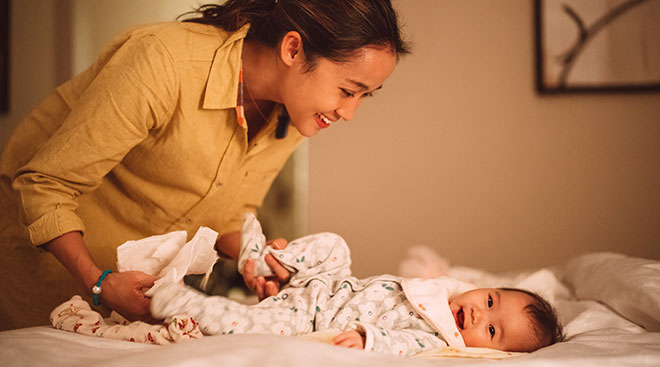


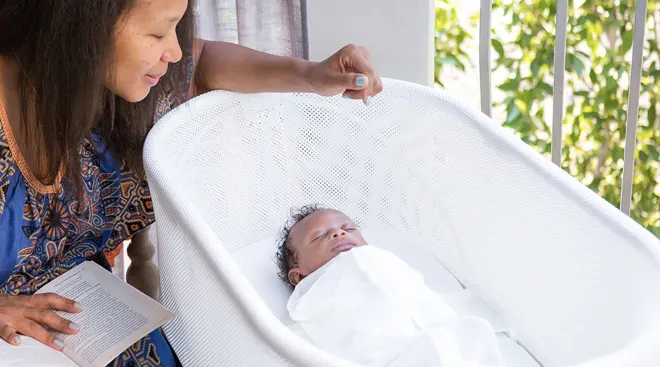
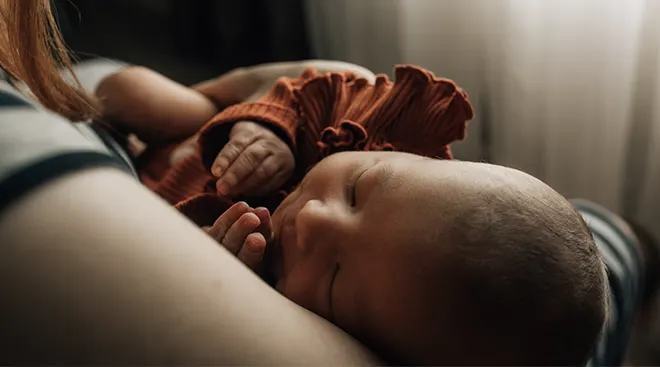


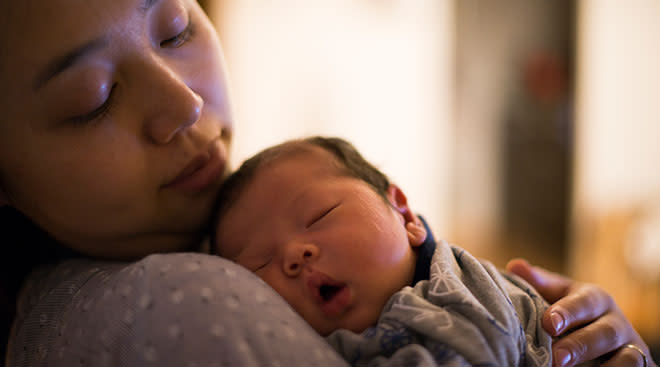
![Tan France, celebrity personality from the popular TV shoe]w Queer Eye.](https://images.ctfassets.net/6m9bd13t776q/2uqRZn7bkb4nWv28drOW16/98b7493289f8f84d699ffa7516be8f90/tan-france-baby-sleep-products-660x367.jpg?q=75&w=660)
